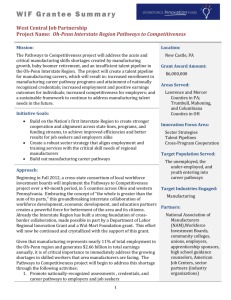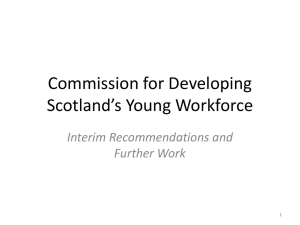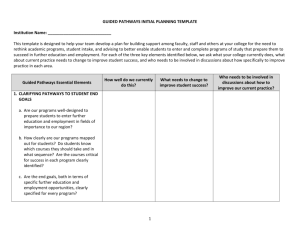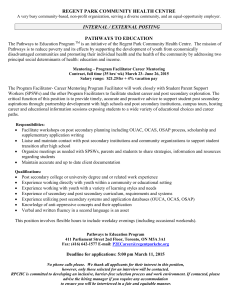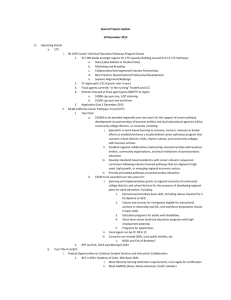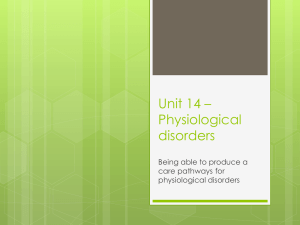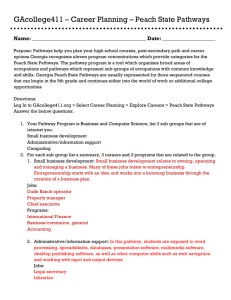Alert_Report_38_WSC_July_2007
advertisement
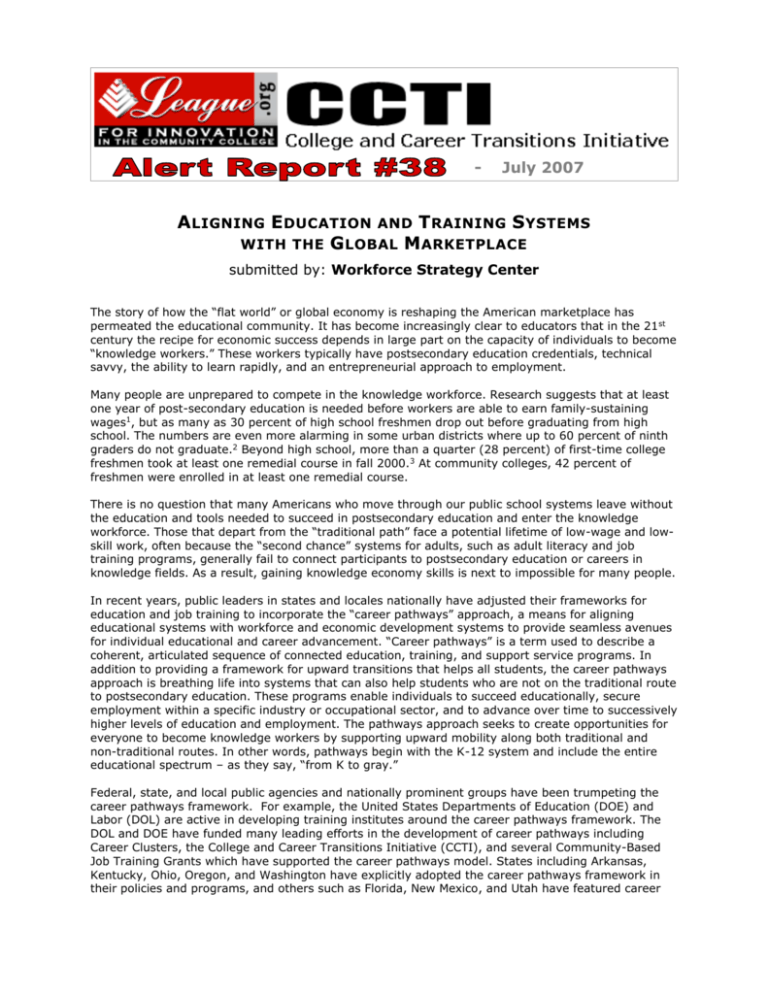
- July 2007 A LIGNING E DUCATION AND T RAINING S YSTEMS WITH THE G LOBAL M ARKETPLACE submitted by: Workforce Strategy Center The story of how the “flat world” or global economy is reshaping the American marketplace has permeated the educational community. It has become increasingly clear to educators that in the 21 st century the recipe for economic success depends in large part on the capacity of individuals to become “knowledge workers.” These workers typically have postsecondary education credentials, technical savvy, the ability to learn rapidly, and an entrepreneurial approach to employment. Many people are unprepared to compete in the knowledge workforce. Research suggests that at least one year of post-secondary education is needed before workers are able to earn family-sustaining wages1, but as many as 30 percent of high school freshmen drop out before graduating from high school. The numbers are even more alarming in some urban districts where up to 60 percent of ninth graders do not graduate.2 Beyond high school, more than a quarter (28 percent) of first-time college freshmen took at least one remedial course in fall 2000.3 At community colleges, 42 percent of freshmen were enrolled in at least one remedial course. There is no question that many Americans who move through our public school systems leave without the education and tools needed to succeed in postsecondary education and enter the knowledge workforce. Those that depart from the “traditional path” face a potential lifetime of low-wage and lowskill work, often because the “second chance” systems for adults, such as adult literacy and job training programs, generally fail to connect participants to postsecondary education or careers in knowledge fields. As a result, gaining knowledge economy skills is next to impossible for many people. In recent years, public leaders in states and locales nationally have adjusted their frameworks for education and job training to incorporate the “career pathways” approach, a means for aligning educational systems with workforce and economic development systems to provide seamless avenues for individual educational and career advancement. “Career pathways” is a term used to describe a coherent, articulated sequence of connected education, training, and support service programs. In addition to providing a framework for upward transitions that helps all students, the career pathways approach is breathing life into systems that can also help students who are not on the traditional route to postsecondary education. These programs enable individuals to succeed educationally, secure employment within a specific industry or occupational sector, and to advance over time to successively higher levels of education and employment. The pathways approach seeks to create opportunities for everyone to become knowledge workers by supporting upward mobility along both traditional and non-traditional routes. In other words, pathways begin with the K-12 system and include the entire educational spectrum – as they say, “from K to gray.” Federal, state, and local public agencies and nationally prominent groups have been trumpeting the career pathways framework. For example, the United States Departments of Education (DOE) and Labor (DOL) are active in developing training institutes around the career pathways framework. The DOL and DOE have funded many leading efforts in the development of career pathways including Career Clusters, the College and Career Transitions Initiative (CCTI), and several Community-Based Job Training Grants which have supported the career pathways model. States including Arkansas, Kentucky, Ohio, Oregon, and Washington have explicitly adopted the career pathways framework in their policies and programs, and others such as Florida, New Mexico, and Utah have featured career CCTI Alert Report #38 Page 2 pathways at statewide conferences. National organizations including the League for Innovation in the Community College, the National Council for Workforce Education, the Association of Community College Trustees, the American Association of Community Colleges, and Workforce Strategy Center have been advocates for the career pathways model. In the work of Workforce Strategy Center (WSC), we have come across many examples of how career pathways principles can improve opportunities for all individuals, including those not on the traditional path. In Lima, Ohio, for example, manufacturing is predicted to remain the region’s predominant industry in the coming years, with job demand expected to be strong. Additionally, retirements are expected to generate many new openings. To get a handle on the jobs being created in the sector, Rhodes State College in Lima conducted a 10-county survey and had nearly 50 in-depth conversations with manufacturing employers to learn about their hiring needs. Following the conversations, the college formed a consortium of employers around issues of training and education. In addition to employers, local high schools, joint vocational centers, adult education providers, and the WIA OneStop Centers have also joined the consortium. The employers and providers in the consortium have designed a pathway to create opportunities for work in entry-level through advanced-level manufacturing jobs. Employers hold regular curriculum reviews to ensure that the program is up to date. The basic level encompasses short-term non-credit training resulting in an employer recognized certificate and is designed for students with high school diplomas and GEDs. Tuition for training can be covered by WIA vouchers or adult education dollars. The intermediate level offers students the option of specializing in one of seven areas and results in the award of a credit-bearing industry certificate. Every employer in the consortium offers tuition reimbursement for this training to students who are incumbent workers. The advanced level certificate is awarded in conjunction with an associate degree. Opportunities for higher education are open ended once students complete associate degrees. The breadth of the partners involved in the consortium ensure that the pathway serves students with a wide spectrum of skill and educational levels, and that each level of the pathway explicitly prepares students for specific employment opportunities and the next level of education. The availability of a robust system of wrap around support services improves the chances of success among participants. Additionally, employers benefit from the skill level and preparation of the regional workforce. Pathways like this one create multiple avenues for students and workers to enter and exit the educational system based on their individual circumstances, while at the same time delivering skilled workers to regional employers. The multi-tiered characteristic of the system, the breadth of resources brought to bear by the partners, and the high involvement of employers all make the career pathways system well positioned to serve people regardless of their starting point. Ultimately, pathways generate opportunities for more people to move up educational and career ladders while acquiring the necessary credentials and skills to compete in the knowledge workforce and achieve economic success. __________________________________________________________________________________________ Prince, D. and Jenkins, D. “Building Pathways to Success for Low-Skill Adult Students: Lessons for Community College Policy and Practice from a Statewide Longitudinal Tracking Study.” (Olympia: Washington Bridges to Opportunity Project, April 2005). 2 Warford, L. “Pathways to Student Success.” (Phoenix: League for Innovation in the Community College, 2006). 3 Parsad, B. and Lewis, L. “Remedial Education At Degree-Granting Postsecondary Institutions in Fall 2000,” NCES 2004-010, (Washington, DC: Institute for Education Sciences, U.S. Dept of Education, November 2003).
